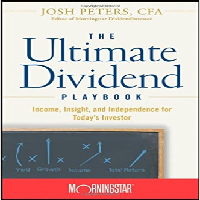 There are too many investing books published about some cheesy trading secret formula that no one in their right mind should follow. This book is one of the few that doesn’t fit into that category. Josh Peters of MorningStar makes it very clear: this is a book about putting together a dividend portfolio that is successful.
There are too many investing books published about some cheesy trading secret formula that no one in their right mind should follow. This book is one of the few that doesn’t fit into that category. Josh Peters of MorningStar makes it very clear: this is a book about putting together a dividend portfolio that is successful.The Ultimate Dividend Playbook: Income, Insight and Independence for Today’s Investor
The author opens the book with three key points on dividend paying stocks that remain for the rest of the text. These points are fundamental to understanding the background of the author but also what he assumes of dividend stocks.
- Income – Remember that dividend income is the goal not capital gains
- Insight – Dividend paying stocks by nature exhibit far more financial health, growth, etc. than their peers
- Independence – Moves investors away from unreliable capital gains (too much chasing) and onwards without gambling or speculation
Dividend Paying Stocks vs. All Other Stocks
In the first portion of the book following the introduction, Josh Peters makes a very distinct and bold point that the book is not a get rich quick scheme. Not only is his strategy no secret but he very bluntly argues that dividend income is a long term process. It is not necessarily buy and hold but it shuns chasing stocks.
This leads well to the next section of the book that tries to very bluntly debunk other types of stocks (growth or penny) and does so in convincing fashion. The argument is quite simple: yes some will get rich on growth or penny stocks but their returns will not be predictable over a period of time nor will they be anywhere among the majority of investors. The important follow up is that he does acknowledge dividends are subject to risks like all other stocks. The idea though is his strategy will help you guide yourself in the right direction.
Peters is essentially trying to shift momentum in investors’ minds, away from watching quotes all day. The thought process is to be giving yourself an income stream regardless of what everyone else is chasing. Historically speaking, the best investing has been accomplished when moving away from the crowd, regardless of how difficult it may be.
Like any book on investing, The Ultimate Dividend Playbook also gives a short and basic primer on the value of stocks and bonds as investments for anyone who needs to brush up on the language and basic guidelines.
Dividend Insight
So we said, Peters acknowledges the risk of dividend stocks, but how far does he go? One thing I have thoroughly enjoyed about reading from The Ultimate Dividend Playbook is that it is very honest. The author does an excellent job of providing concrete proof that dividend stocks are in themselves somewhat dangerous investments. He compares them to bonds, in that companies can go up or down at any time along with their dividends. Whereas bonds are fixed income that have no worry of running away.
The author then makes a bold statement that many proponents of technical analysis will grind their teeth with: dividend payout history is more helpful and telling of a stocks performance than charts. The manner in which he addresses his position is very entertaining but after looking into it, it really is not that incredible. That is because the book we are reading is about the ability of the dividend, not the capital gains.
“Past Performance is no Guarantee…” Well There’s a Good Chance it Could be!
We’ve all heard that phrase in one context or another, whether we were reading a quarterly report or looking at a mutual fund. Of course it is an excellent point to remember, with dividend stocks past performance may be an incredibly useful tool. For starters it is an incredibly useful tool to look at correlations between the health of the company in question and their dividend.
The sad reality though is that dividend yields are likely to get lower and lower in the future. Past trends show this clearly in Peters’ data. The author claims that on average the market can expect 5-7% dividend growth up against 7-9% market average.
Sucker Dividend Yield Stocks – High Yielders
When I first started investing in dividend stocks I looked for the highest yielding examples to add to my portfolio like so many others. Guess what happened? I lost big time! The Ultimate Dividend Playbook does a great job of explaining why this happens and explains how you can judge which yields are appropriate for each company.
Some examples of strategies he uses from the text include looking at the stability of earnings. Are those earnings sufficient to cover the dividend? What about the future? What is management doing to keep that pace? Certain sectors, industries and market caps have common expectations for dividend yield. It would be who of you to learn them.
Conclusion: Worthy addition to your Bookshelf
First of all, I found The Ultimate Dividend Playbook to be very thorough with perfect examples of what the author was trying to articulate. He has many excellent hypothetical questions for you to ask yourself as you are working through the book, many of which are entertaining. Finally the appendix caters to a lot of great definitions and explanation for anything discussed previously but also outside the framework of the book.
The Ultimate Dividend Playbook: Income, Insight and Independence for Today’s Investor